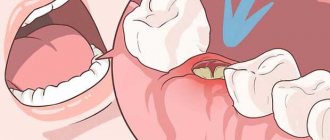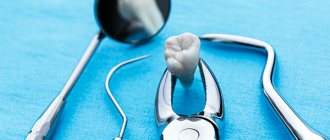A day later, he died from suffocation and extensive purulent inflammation of the throat and face.
Igor’s uncle came to the editorial office of “Nasha”. The strong man could hardly hold back his tears: talking about how, as a result of a banal tooth extraction, his family lost a loved one was incredibly difficult.
There are, on average, fifty such extractions a day in the city dental clinic, but this tooth turned out to be truly fatal for everyone.
“I don't care about anyone being punished. “You can’t bring Igor back,” Nikolai said, trying to hide his pain. “I just want our grief to serve as a good lesson to other people.” So that they can demand, defending their rights.”
Content:
- Peculiarities
- Indications
- Contraindications
- Operation
- Removal methods
- Difficult removal
- Stages
- Diagnostic value
- Does it hurt to remove
- Possible complications
Wisdom teeth or “eight” teeth, located at the edges of the jaw, erupt much later than their counterparts. Moreover, this often happens in adulthood, causing a person many unpleasant moments. The fact is that the structure of the human jaw does not provide enough free space to comfortably accommodate an additional pair of teeth. Therefore, “eights” often put pressure on “sevens”, they grow at an angle, their roots become curved, and it can be difficult to provide them with proper hygienic care, as a result of which caries develops. The peculiarities of the location do not allow for high-quality treatment of the wisdom tooth, and the optimal solution is its removal, since it bears neither a functional nor an aesthetic load.
Everyone is right, no one is to blame. But there is no person...
The mother and sister of Igor Dubovsky, who came to our editorial office, complained that they had met with Vaclav Yasvin, the head of the city dental clinic, but did not receive a clear explanation why a healthy 45-year-old man could die due to a pulled out tooth. The women, who had cried all their tears, wanted to look into the eyes of the doctor who pulled out the ill-fated tooth, but they were not able to meet him on Tuesday. On that tragic day for the Dubovsky family, Doctor Shingarev was completing his last working day before rest: long holidays awaited him, and on Monday he began his legal vacation.
And here is what Mr. Yasvin said in a conversation with Nasha Gazeta: This is an unprecedented case for our clinic. We are now conducting a serious investigation into this fact. I personally express my most sincere condolences to Igor’s loved ones. I interviewed the clinic staff who worked in those days. I have no reason not to believe the experienced doctor who is Dmitry Shingarev. But he did not notice a tumor on Dubovsky’s face, and therefore did not prescribe antibiotics to the patient. Regarding the appointment of the doctor on duty on June 23: we have an unspoken rule - doctors work until the last patient in the clinic premises. That day, the doctor on duty worked until half past four, and if Dubovsky had not left, he would have definitely been seen. As his relatives said, the man himself was very afraid of dentists, which is why he started the disease. he needed to be persistent himself and tell the doctor what was bothering him, and not leave the clinic.”
As Nasha Gazeta learned, yesterday Dr. Shingarev returned from vacation to personally meet and talk with the relatives of the deceased patient...
From the editor: Of course, we are not a spoiled people: we have been doing home renovations ourselves for a long time, we try to fix household appliances and cars ourselves. Why don’t we now start understanding medicine ourselves? But in this case, another question haunts me: if the specialist “didn’t notice anything suspicious,” then how can we, people far from medicine and dentistry, understand something? 40-60 removals per day... It turns out that doctors work like on an assembly line: if it hurts, remove it, and then let the patient fuss about it... Now all you hear around is: doctors think they are underpaid. But we, patients, know for sure that we pay too high a price for our medicine. Life...
Features of the structure of wisdom teeth
The structure of a wisdom tooth is no different from other molars and consists of a neck, a root system (4–5 pieces) and a crown. In some cases, root development is disrupted and a single conglomerate is formed, that is, a tooth grows with one root.
Its only difference from its neighbors is that recent studies recognize the wisdom tooth as a rudiment that has lost its functional purpose during the evolutionary development of man. Scientists do not consider it as a full-fledged organ, since some part of humanity does not grow it at all.
However, the wisdom tooth has several parameters that distinguish it from the same “seven”:
- lack of milk precursors, which ultimately complicates eruption and impedes growth. There is no room left for it on the dental arch, which is why various developmental pathologies arise;
- the number of roots is greater than that of other molars - up to 5 pieces. In this regard, problems often arise when removing a wisdom tooth;
- significantly curved roots of the “eights” make cleaning and treatment of root canals very difficult;
- poor blood supply compared to other teeth leads to rapid aging, accompanied by fragility and susceptibility of tissues to caries, despite minimal load;
- many pathological conditions, for example, pathologies of the masticatory muscles, malocclusion, pericoronitis, are associated with the growth of “eights”.
Thus, the appearance of third molars has many more negative consequences than positive ones. Many patients are forced to see a dentist even before they can be seen in person.
But it was necessary not to endure, but to insist!
Holding back tears, the relatives reconstruct in order the story of the last two days of Igor Dubovsky’s life.
It is very difficult to speak in the past tense about a person who just a few days ago was full of life, strength, and health. It is even more difficult to imagine what enormous grief befell Igor’s family and his mother during these holidays: after all, for a mother’s heart there is nothing worse than outliving her son. Moreover, when he was overtaken by such a stupid, such an absurd death because of someone’s negligence, callousness, indifference and desire to “quickly rest”, hastily getting rid of an unwanted patient.
On June 22, when Daugavpils residents were massively purchasing groceries in joyful anticipation of the long league weekend, Igor began to be bothered by a seemingly ordinary toothache. My cheek began to swell. On the advice of friends, he went straight to the emergency room of the Daugavpils Regional Hospital. But no one there even looked at his tumor and offered no advice. Igor was simply turned around and kicked off to the city dental clinic. By the way, they actually deployed their colleague, because Igor also worked in the healthcare system - he was a driver in a city psychiatric hospital.
What to do if Igor was such a person: very calm, unable to “bump his fist” and get his way, embarrassed to cause unnecessary trouble to others. That is why he did not insist, but, patiently enduring severe pain, went to the other end of the city, to the street. Lachplesha.
And here I would like to ask our doctors the first question (apparently, rhetorical): “Dear sirs, what about the patient’s legal right to receive emergency medical care? How about the same legal right to freely choose a doctor and medical institution? Or has it already been canceled in Daugavpils?!”
Yes, according to the rules, a referral to a hospital is given either by a family doctor or a specialist. But if a person is in a lot of pain and he has already come to you! Is it really not possible to just carefully examine, understand, advise, give advice on how to remove the tumor, or at least give painkillers. And don’t push away from the patient like hell from incense. You're still at work! Or is normal human behavior in a hospital emergency room already “outlawed” in our country?!
Indications for wisdom tooth removal
Treating third molars is a challenging task, but a competent dentist will try to keep the unit relatively healthy. However, in practice, even relatively healthy “eights” are extremely rare.
Most often, problems begin at the teething stage, which is associated with pain, fever, swelling and other troubles. The doctor prescribes wisdom tooth removal if:
- an unerupted molar is incorrectly positioned in the jaw, injuring neighboring teeth and soft tissues;
- extensive caries damage with significant destruction of the crown;
- pericoronitis (presence of an inflamed hood);
- installation of a bracket system. Sometimes only the removal of a wisdom tooth can ensure the correct movement of other molars;
- presence of a cyst;
- the trigeminal nerve is pinched;
- pulpitis, periodontitis.
Most experts are inclined to believe that the “eight” should be under the supervision of a doctor from the moment of eruption. An x-ray is sufficient to assess the development of the tooth and assess future prospects. This needs to be done immediately, if only because for young people the rehabilitation period is much easier and the likelihood of complications is minimal.
Contraindications to wisdom tooth removal
Despite all of the above, there are situations when the mouth cannot do without the “eight” or the operation cannot be performed for other reasons:
- you need to install a bridge supported by the third molar;
- adjacent molars become loose, and a wisdom tooth is used as a base for applying a splint;
- due to the absence of chewing molars, the chewing function falls on it;
- period of pregnancy and breastfeeding;
- cardiovascular pathologies;
- impaired blood circulation;
- allergy to anesthetic;
- hypertensive crisis.
Simple wisdom tooth removal method
For a simple operation, the surgeon uses forceps and an elevator without resorting to incisions or drilling into the bone. This method allows you to extract a molar if:
- the upper wisdom tooth needs to be removed;
- there are no significant developmental deviations;
- there are no complicating circumstances.
Wisdom tooth removal proceeds as follows:
- 1. The dentist collects anamnesis, inquires about the patient’s allergic reactions to medications, and selects the optimal anesthesia;
- 2. an anesthetic drug is administered, its effect begins after about 5 minutes;
- 3. the surgeon prepares instruments, the sets of which differ depending on the location of the tooth, its condition, and the presence of inflammation;
- 4. Using forceps or using an elevator, the tooth is removed from the socket;
- 5. The doctor treats a fresh wound with antiseptic drugs;
- 6. If necessary, an anti-inflammatory agent is placed in the hole.
After the removal of wisdom teeth, large sockets remain, so the surgeon sutures the tissue to prevent infection and speed up healing. In the presence of purulent processes and inflammation, suturing the hole is not advisable, since the contents must have an unimpeded outflow. The manipulation usually takes no more than 10 minutes. To monitor the patient’s condition, the doctor schedules an examination a few days after the operation to remove the diseased wisdom tooth.
In Orenburg, a schoolgirl died after dental surgery
In Orenburg, a nine-year-old schoolgirl died after a routine dental operation. This was reported by the Investigative Committee of Russia for the Orenburg Region.
According to the Orenday.ru portal, the child was bothered by painful sensations in the mouth due to the fact that the supernumerary tooth interfered with the growth of the molar. The girl needed surgery, but it was postponed for a long time due to the coronavirus pandemic.
As a result, the doctors still asked to bring the schoolgirl to the clinic. On September 23, a family friend brought her there because her parents could not take time off from work. On September 24, the operation began - as the dentists said, the procedure was ordinary and absolutely safe.
The patient had an extra tooth removed, but then problems began - doctors could not bring the schoolgirl out of anesthesia. Their efforts were unsuccessful - the girl died.
“After the operation, due to hyperthermia, she was urgently transferred to intensive care. Doctors tried to save the girl, carried out the necessary measures, but at 13:10 the death of the minor was recorded,” said the investigative department of the Investigative Committee of Russia for the Orenburg region.
The child's parents immediately contacted the police and prosecutor's office. Investigative Committee staff conducted a survey at the hospital. An autopsy of the girl's body was performed in the presence of a prosecutor. The results of the examination are now awaited. At the same time, law enforcement officers do not rule out that the schoolgirl died due to the intervention of doctors.
In addition, investigators opened a criminal case under Part 2 of Article 109 of the Criminal Code of the Russian Federation - causing death by negligence due to improper performance by a person of his professional duties. They are currently working with the staff and management of the clinic, and documentation that may be related to the incident has been seized.
“To objectively establish the circumstances of the incident, the prosecutor’s office will have to draw conclusions about the hospital’s compliance with all necessary standards and requirements, including information interaction with certain services,” the prosecutor’s office noted.
Earlier, on March 6, 2022, in Penza, a traumatologist, due to whose mistake a six-year-old boy died, was sentenced to one and a half years of restriction of freedom with further deprivation of the right to practice medicine for two years. This was reported to the RF IC.
A six-year-old boy was admitted to the Penza emergency room on October 6, 2018 with complaints of pain in his right hand. The doctor, who was acting as the head at that time, diagnosed the child with a “fracture of the right arm,” but did not pay attention to the temperature and swelling that appeared in the patient.
According to the Investigative Committee, he underestimated the severity of the injury and did not admit the boy to the hospital to conduct a detailed diagnosis to clarify the diagnosis. Instead, the traumatologist put him in a cast and sent him home.
The boy’s father told the Our City Online portal that by the evening his son’s temperature reached 40 degrees. The fever subsided only after the injection, which was given by emergency doctors. On the morning of October 8, the parents went with the boy to another doctor. “He said that the child’s arm had been put in a splint, and he re-wrapped it,” the father reported.
According to him, by the evening the hand swelled even more, after which the parents again called an ambulance. However, this time they were completely dissuaded from hospitalization.
“At one o’clock in the morning the convulsions began. The son was taken by ambulance to the regional children's hospital. The doctors fought for his life for three hours, but it was too late,”
- said the father.
The boy died at night in the Penza regional hospital named after. Filatova. In the report of the Investigative Committee of the Investigative Committee, the cause of death was named acute liver and heart failure, which developed due to the syndrome of prolonged compression of the soft tissues of the hand.
The godfather of the deceased child clarified that calling an ambulance for the boy was problematic. “Four ambulances didn’t take him, only the fifth took him,” he explained to the Our City Online portal.
The man believes that the director of the emergency room is to blame for what happened. “There was a fracture of his arm, they put him in a plaster cast, tightened it, because of this, tissue necrosis began and intoxication went to the brain,” the godfather wrote in the Penza Live community on the Vkontakte social network.
On March 6, 2022, the Leninsky District Court of Penza sentenced the head of the trauma center under the article “Causing death by negligence due to improper performance of professional duties.”
Complex wisdom tooth removal
During such an operation, the surgeon uses many more instruments and performs more complex manipulations, in particular, cutting soft tissues and suturing the incision without fail.
Complex removal is carried out if:
- we are talking about removing the lower wisdom tooth;
- there is an abnormal root system;
- the coronal part is severely destroyed;
- impacted, dystopic molars.
Preparation for the operation follows approximately the same pattern as for simple wisdom tooth removal, but this is where the similarities end. This is noticeable already at the initial stage: more time is allocated for the effects of anesthesia - about 10 minutes.
Fact
“Nasha” contacted the Health Inspectorate regarding the incident. Here they explained to us that Igor Dubovsky’s relatives must write a statement, which they can submit to the Latgale branch of this inspection. But it’s better to send him to Riga right away.
“I have already warned my colleagues about this case, and we are waiting for their statement,” the Health Inspectorate employee told us at the end of the conversation.
We remind you that you should send your complaints to the Health Inspectorate at the following address: Klijānu iela 7, Riga, LV-1012, Veselības inspekcija. Contact phone: 67819671; fax: 67819672. Email address; website www.vi.gov.lv.
Stages of complex wisdom tooth removal
The methodology may differ for each specific case, but in general terms several approximate stages can be outlined:
- 1. local anesthesia;
- 2. incision of soft tissues, peeling them off the bone;
- 3. sawing, drilling out the proper bone tissue;
- 4. extracting the “eight”;
- 5. treatment of a fresh hole left after the removal of a diseased wisdom tooth;
- 6. suturing with non-absorbable suture material;
- 7. The doctor will remove the stitches only after the edges of the wound have completely fused.
The duration of the procedure depends on the situation and can last from 30 minutes to 2 hours. After the operation, the doctor advises the patient regarding wound care, prescribes medications and informs the date of the next appointment.
The value of x-ray diagnostics when removing wisdom teeth
No qualified doctor will remove wisdom teeth “blindly”. You cannot rely on external indicators. A clear assessment of the condition of the root system and the development of the tooth is necessary in order to eliminate complications that could arise after the operation. An x-ray must be taken to assess the feasibility of removing a particular wisdom tooth.
X-ray examination provides an informative picture that allows you to see:
- the presence of curved roots;
- number of root shoots;
- structural features.
Based on the results of X-ray diagnostics, the doctor will be able to draw up a surgical plan and eliminate errors in the form of bone fragments remaining in the gum.
Is it painful to remove a wisdom tooth?
Many patients delay wisdom tooth removal due to fear of pain. Such fears in modern dentistry are absolutely groundless, since anesthetics are necessarily used for the procedure. Discomfort occurs when the effect of the drugs wears off and the analgesic effect decreases. But this is a physiological process that fades away on its own after some time. In addition, there is absolutely no need to endure pain; the doctor will prescribe medications to alleviate the postoperative condition.
When removing a wisdom tooth, some patients experience painful symptoms for a number of reasons:
- drug addiction;
- extensive purulent process;
- abuse of painkillers.
Also, the degree of pain depends on the method of removal, the condition of the wisdom tooth, and its location. For example, surgery on the upper jaw is easier. But removing a wisdom tooth from the lower jaw is more problematic due to the structural features of the jaw and large curved roots.
“They don’t die from this!..”
In dentistry, Igor had an appointment with Dmitry Shingarev, a certified doctor with extensive professional experience and an excellent reputation, a truly excellent specialist. As the doctor himself now says, he did not notice any tumor. And Igor was again embarrassed to say that he felt very bad, believing that the doctor knew better. To be honest, he was afraid of dentists since childhood.
The tooth was safely removed, and the patient was told to rinse the wound with chamomile infusion. All. The freezing worked, the pain began to subside, and Igor, sighing with relief, went home.
However, at home, the tumor not only did not subside, but began to increase. Igor suffered all night, but endured until the last, because the doctors seemed to have done everything that was necessary. Chamomile didn't help. During the day the swelling spread from the face to the neck. Igor could not stand it and again went to the clinic, which that day worked according to the weekend schedule - the doctor on duty was on duty until 15:00.
Now no one can say for sure which particular employee or visitor to the dental clinic told Igor that they wouldn’t be able to see him anyway - goodbye. Only one thing is known: he gave in again and patiently went home.
In the evening, Dubovsky began to experience severe suffocation. The ambulance that was called could not help him and was forced to call the resuscitation team. But the latter were also powerless...
The epicrisis (doctor's report) indicates the cause of Igor's death: asphyxia (suffocation), extensive purulent phlegmon (inflammation) of the throat and face.
As the pathologist told Igor’s relatives, they don’t die from this.” Apparently, the doctor meant that such problems are easily solved by modern medicine, and such cases should not end in death. If only... it weren’t for a series of examples of banal medical negligence, sometimes reaching the point of basic disregard.
Don't they die from this? Maybe somewhere they don’t die... But in Daugavpils they do! Healthy, full of energy men...
Possible complications
Wisdom tooth removal is one of the most difficult operations in dentistry. Therefore, after it is carried out, various complications cannot be excluded. Thus, during the operation, neighboring “sevens” are sometimes damaged. Such severe consequences are the result of incorrectly chosen treatment tactics, as well as the low qualifications of the dentist, who was unable to understand the peculiarities of the patient’s anatomical structure.
Mature patients in some cases experience damage to the nervous system and, as a result, impaired sensitivity and numbness. Young patients encounter such disorders much less frequently.
A few hours after the removal of a wisdom tooth, bleeding may develop, which is most often provoked by intense rinsing, irritating the wound with the tongue, or eating hot food. This disorder is especially dangerous for patients suffering from hypertension and bleeding disorders.
Dry socket is the most common postoperative complication. Normally, after a wisdom tooth is removed, a blood clot forms in the socket, which promotes rapid healing of the wound. Sometimes a clot does not form, most often in smokers. After a few days, acute pain may appear, for which you should definitely consult a doctor.











